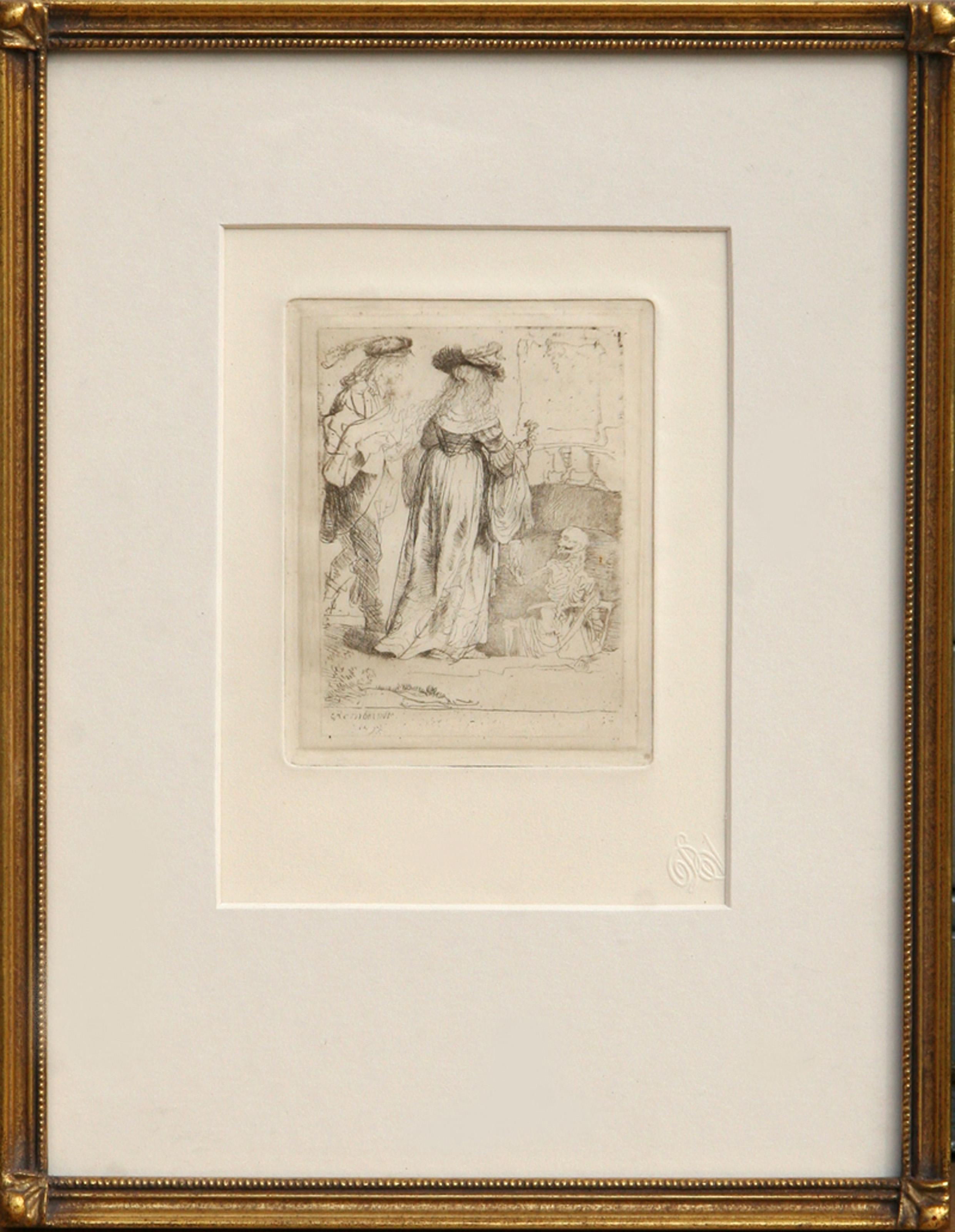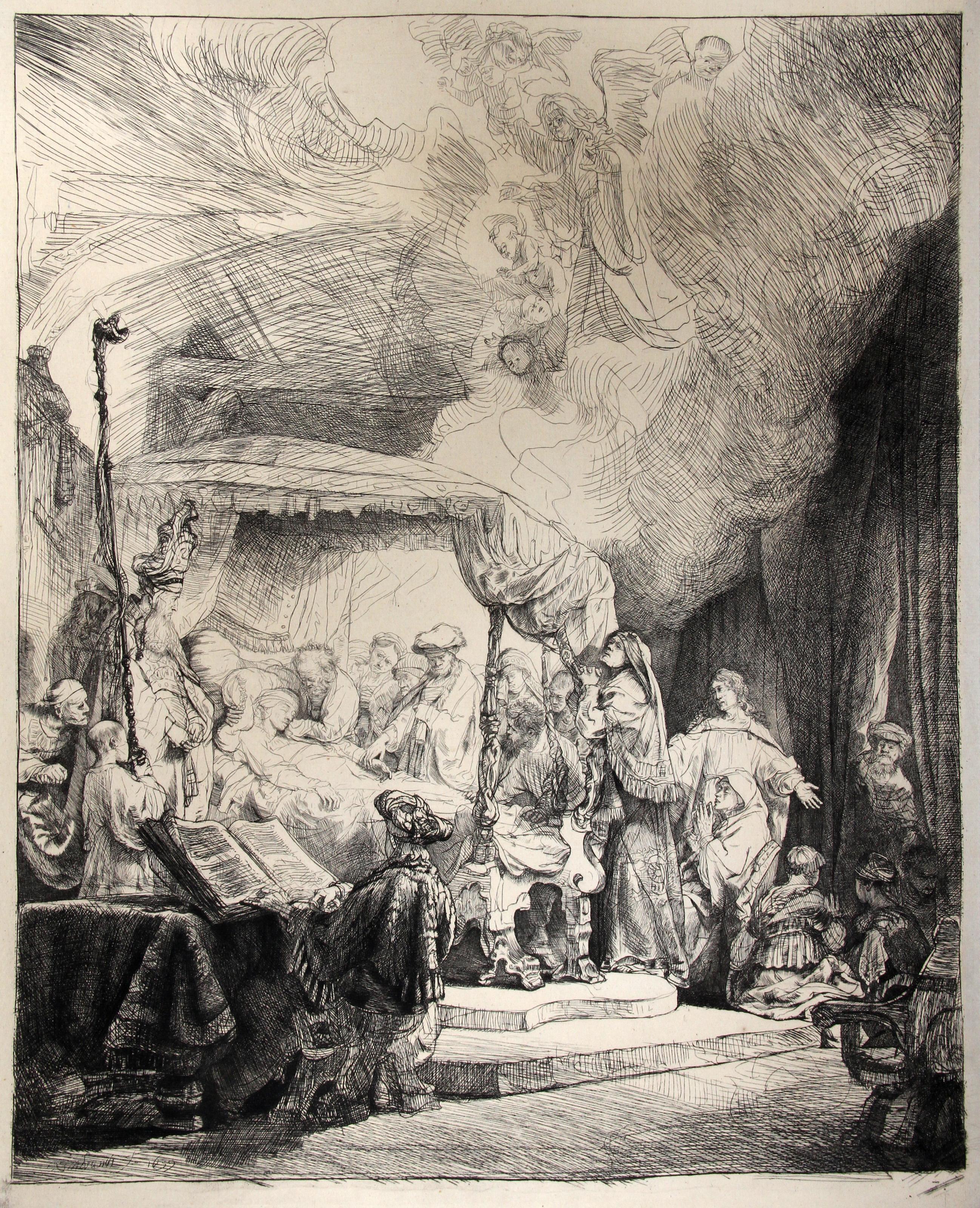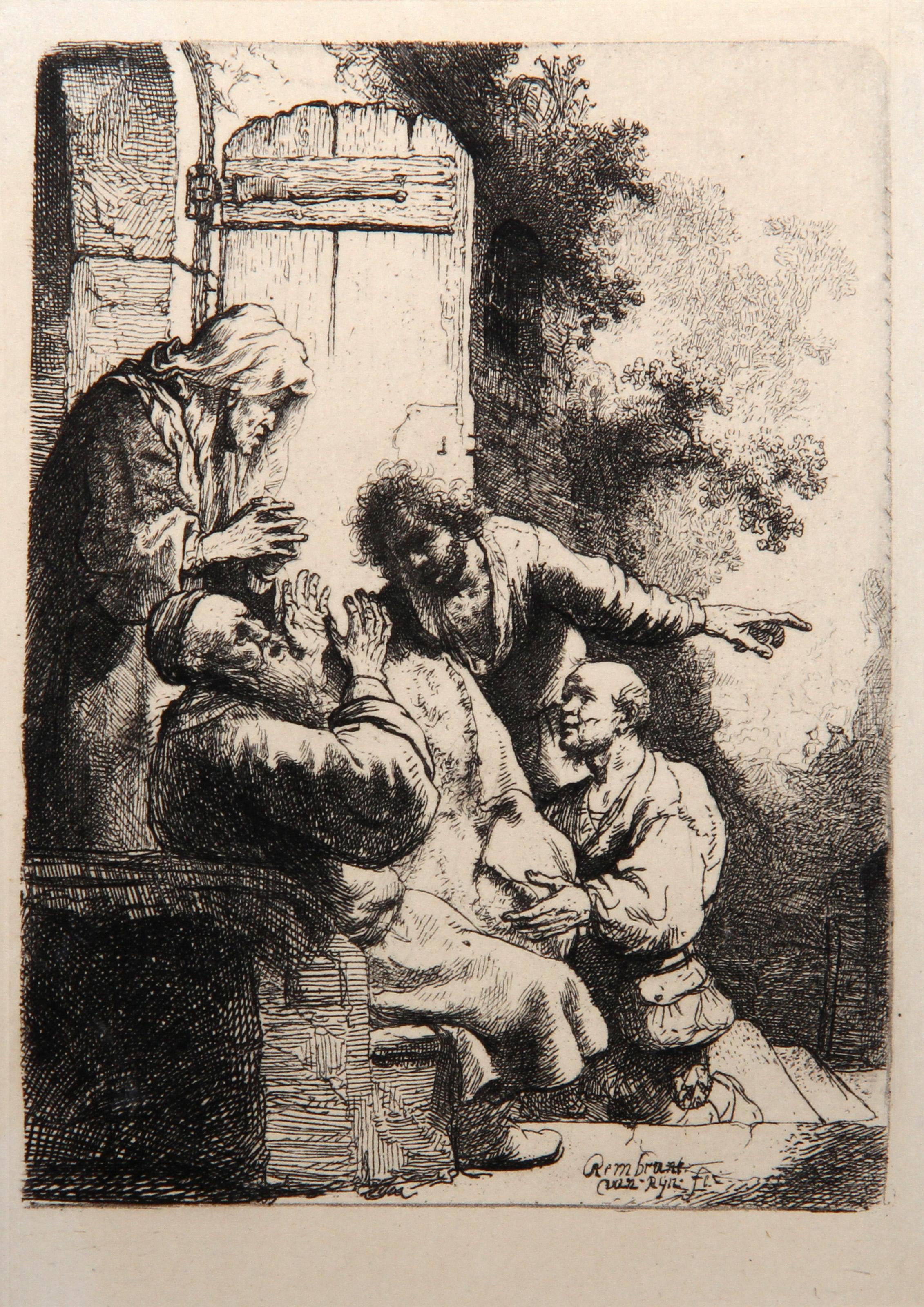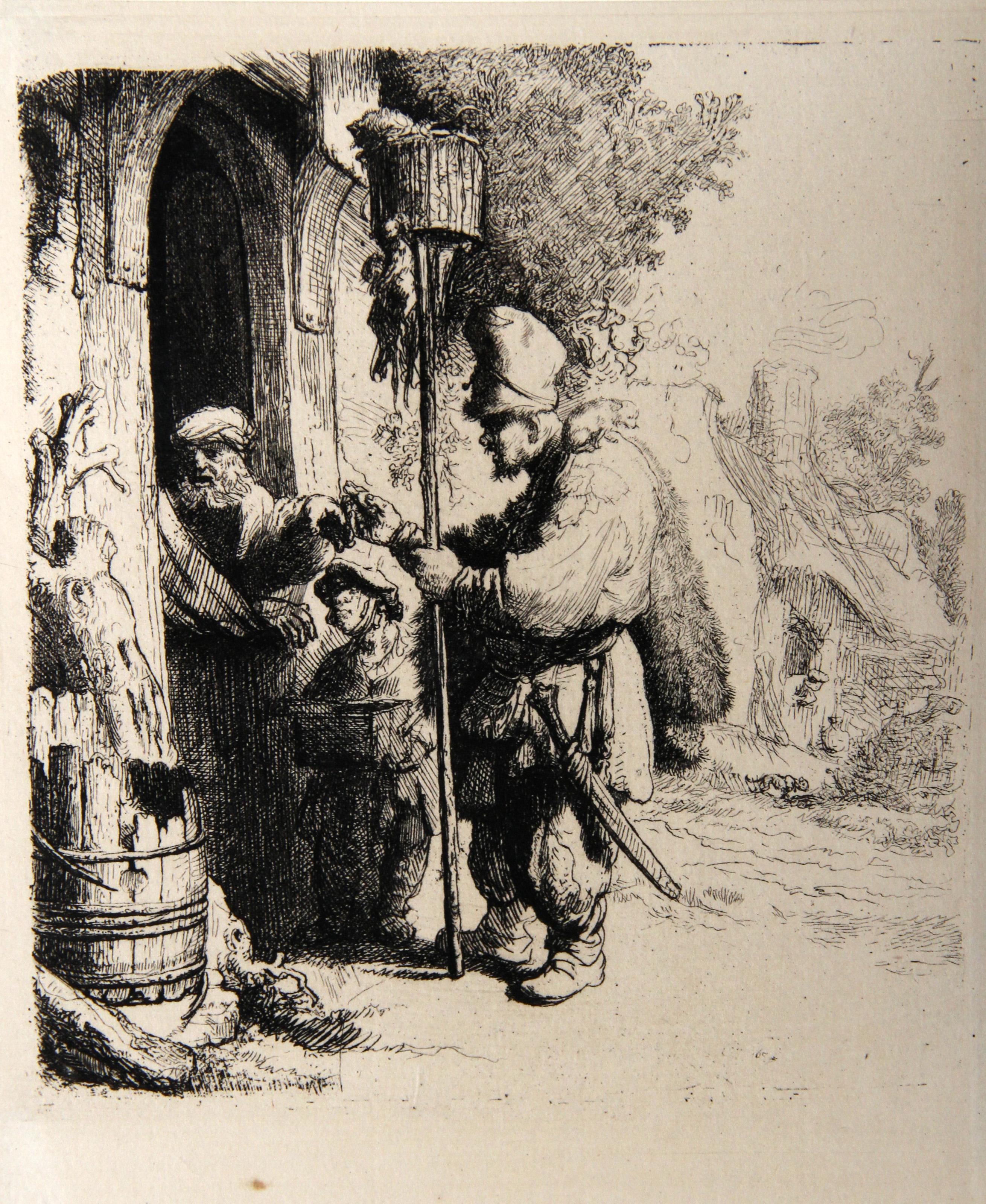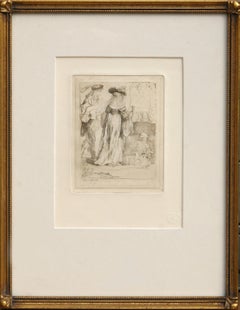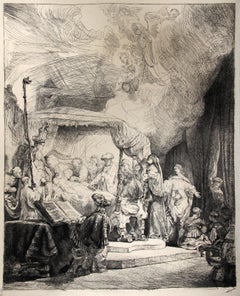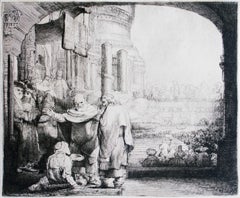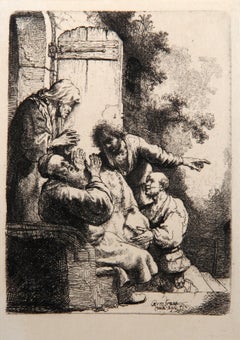Items Similar to Death Appearing to a Wedded Couple from an Open Grave
Want more images or videos?
Request additional images or videos from the seller
1 of 4
Rembrandt van RijnDeath Appearing to a Wedded Couple from an Open Grave1639
1639
Price Upon Request
Price Upon Request
Price Upon Request
Price Upon Request
Price Upon Request
Price Upon Request
Price Upon Request
Price Upon Request
Price Upon Request
Price Upon Request
About the Item
REMBRANDT HARMENSZ. VAN RIJN
1606 Leiden Amsterdam 1669
Death Appearing to a Wedded Couple from an Open Grave 1639
drypoint and etching; 109 x 78 mm
Bartsch 109, White/Boon only state; Hind 65; New Hollstein 174, only state
PROVENANCE: extensive provenance history available on request.
Although the themes of love and death were very popular in seventeenth-century Dutch art, the motifs were usually disguised. This very direct confrontation harks back to such earlier representations as Drers Promenade (Meder 83). Accordingly, the figures themselves are clothed in sixteenth-century costume and seem to be amused rather than frightened by the skeleton before them.
This is an extraordinarily good impression of a delicately wrought plate, with all the very finest lines intact (see, for instance, the lightest lines of her flowing hair, and the proving marks below the borderline), with touches of burr, especially towards the bottom. In later impressions, the sharpness of the lines diminishes, the finest lines break or even disappear. Esdailes impression, now at the Metropolitan, is better than the Morgans, but again there are no light scratches below the border, the hair is weak and there is no burr.
Such is the quality of line, in fact, that the characteristics of both this and the other impressions lead one to suspect that the print may be wholly executed in drypoint.
Even early commentators in the eighteenth century have described this print as rare.
[Note: I’m indebted to colleague Armin Kunz for these notes on this fine print]
- Creator:Rembrandt van Rijn (1606 - 1669, Dutch)
- Creation Year:1639
- Dimensions:Height: 42.92 in (109 cm)Width: 30.71 in (78 cm)Depth: 0.04 in (1 mm)
- Medium:
- Movement & Style:
- Period:1630-1639
- Condition:
- Gallery Location:New York, NY
- Reference Number:1stDibs: LU515313494972
Rembrandt van Rijn
Rembrandt was the most influential 17th Century Dutch painter. After years of early success as a portrait painter, his life was beset by financial hardship and personal tragedy. He continued to paint portraits and develop etchings. Rembrandt's portraits of his contemporaries, self-portraits and illustrations of scenes from the Bible are regarded as his greatest creative triumphs. His self-portraits form a unique and intimate autobiography, in which the artist surveyed himself without vanity and with the utmost sincerity. Like many artists of the Dutch Golden Age, such as Jan Vermeer of Delft, Rembrandt was also an avid art collector and dealer. Rembrandt never went abroad, but he was considerably influenced by the work of the Italian masters and Netherlandish artists who had studied in Italy, like Pieter Lastman, the Utrecht Caravaggists, Flemish Baroque, and Peter Paul Rubens. Rembrandt's foremost contribution in the history of printmaking was his transformation of the etching process from a relatively new reproductive technique into a true art form, along with Jacques Callot. His reputation as the greatest etcher in the history of the medium was established in his lifetime and never questioned since. Few of his paintings left the Dutch Republic while he lived, but his prints were circulated throughout Europe, and his wider reputation was initially based on them alone.
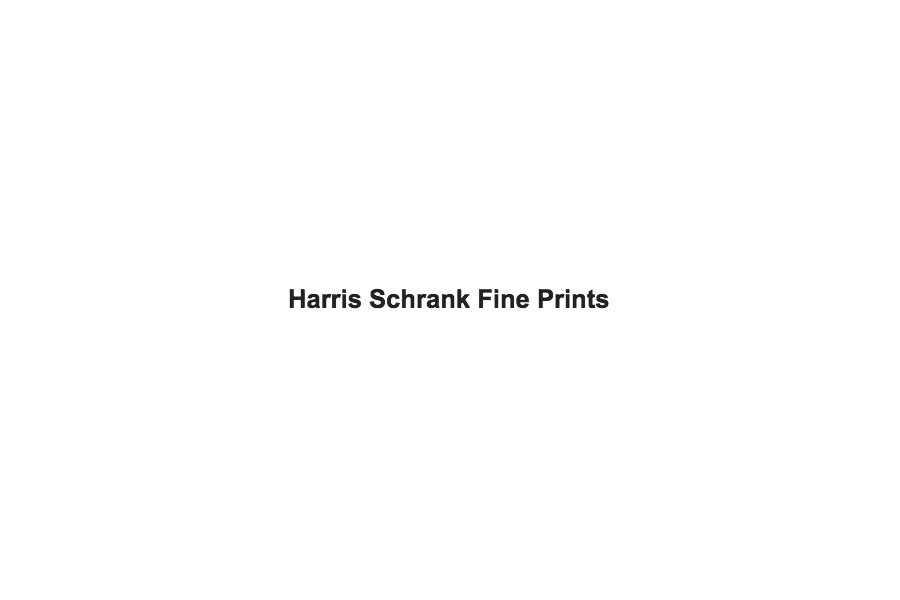
About the Seller
4.9
Recognized Seller
These prestigious sellers are industry leaders and represent the highest echelon for item quality and design.
Established in 2000
1stDibs seller since 2016
108 sales on 1stDibs
Typical response time: 18 hours
Associations
International Fine Print Dealers Association
- ShippingRetrieving quote...Shipping from: New York, NY
- Return Policy
More From This Seller
View AllAbraham and Sarah (Sarah Presenting Hagar to Abraham)
By Georg Pencz
Located in New York, NY
Georg Pencz (1500-50) engraving, c. 1540, Abraham and Sarah (Sarah Presenting Hagar to Abraham). Reference: Bartsch 1, Landau 1, only state. [title...
Category
16th Century Old Masters Figurative Prints
Materials
Engraving
The Anglers
By Adriaen van Ostade
Located in New York, NY
Adriaen Van Ostade (1610-1685) etching The Anglers, circa 1647, Godefry 26, Bartsch 26. Very good condition, with small (1/2 inch) margins, on cream laid paper, archival mounting. 4 ...
Category
1640s Old Masters Landscape Prints
Materials
Etching
A Drunken Night Cap
By Jan van der Bruggen
Located in New York, NY
(After) JAN VAN DER BRUGGEN (Brussels c1649 1690 Paris), A Drunken Night Cap, Wine is a Mocker, mezzotint, c. 1720, with artist's name Mieris lower left in t...
Category
1720s Old Masters Figurative Prints
Materials
Mezzotint
Two Fools (or Fool and Foolish Woman)
By Hans Sebald Beham
Located in New York, NY
Hans Sebald Beham (1500-1550), an engraving after Beham’s Two Fools (or Fool and Foolish Woman), engraving, c 1540, a copy or impression in reverse of Pauli 215, Bartsch 213, the cop...
Category
16th Century Old Masters Figurative Prints
Materials
Engraving
The Young Hostess
By Cornelis Bega
Located in New York, NY
Cornelis Bega (active 1631/32-64), The Young Hostess, c. 1660-64, etching. Reference: Hollstein, Bartsch 33, third state (of 5). With the address of J. Covens and C Mortier bottom left - before the address was removed (in the fourth state) and the artist’s signature was added (in the fifth state). In excellent condition, printed in black/grey ink on an old laid paper, with a 3/16 inch margin outside the plate mark all around, archival matting.
Provenance: Ex collection Graff (with stamp verso, Lugt 1092a), LRV (with stamp verso, Lugt 1761), an unidentified collector’s stamp verso, and Dr. Karl Herveg (his stamp verso, Lugt 3974).
A very good impression, with the guidelines of the address strongly visible.
Dr. Karl Herweg was a noted collector of 17th Century Dutch prints...
Category
1660s Old Masters Figurative Prints
Materials
Etching
The Beggars
By James Abbott McNeill Whistler
Located in New York, NY
James Whistler (1834-1903), The Beggars, etching and drypoint, 1879-80, signed with the butterfly and inscribed “imp”. Reference: Glasgow 190, seventh sta...
Category
1870s Impressionist Figurative Prints
Materials
Drypoint, Etching
You May Also Like
Death Appearing to a Married Couple from an open Grave by Rembrandt van Rijn
By Rembrandt van Rijn
Located in Long Island City, NY
Rembrandt van Rijn, After by Amand Durand, Dutch (1606 - 1669) - Death Appearing to a Married Couple from an open Grave, Year: Of Original 1639, Medium: Etching, Size: 10.5 in. x 8....
Category
Late 18th Century Prints and Multiples
Materials
Etching
La Mort de la Vierge (B99), Heliogravure by Rembrandt van Rijn
By Rembrandt van Rijn
Located in Long Island City, NY
Rembrandt van Rijn, After by Amand Durand, Dutch (1606 - 1669) - La Mort de la Vierge (B99), Year: 1878 (of original 1639), Medium: Heliogravure, Size: 9.25 x 7.5 in. (23.5 x 19.0...
Category
Late 18th Century Old Masters Prints and Multiples
Materials
Etching
Peter and John Healing the Cripple at the Gate... - Etching by Rembrandt - 1659
By Rembrandt van Rijn
Located in Roma, IT
Etching, excellent proof of II state on IV, before the retouching of the ground and the vault on the right, margin line.
Ref. Bartsch, Hollstein 94; Hind 301; New Hollstein 312; Sto...
Category
1650s Old Masters Figurative Prints
Materials
Etching
Jacob Pleurant La Mort de Son Fils Joseph (B38), Heliogravure by Rembrandt
By Rembrandt van Rijn
Located in Long Island City, NY
Artist: Rembrandt van Rijn, After by Amand Durand, Dutch (1606 - 1669) - Jacob Pleurant La Mort de Son Fils Joseph (B38), Year: 1878 (of original 1633), Medium: Heliogravure, Size: ...
Category
Late 19th Century More Prints
Materials
Etching
Le Marchand de Mort aux Rats (B121), Heliogravure by Rembrandt van Rijn
By Rembrandt van Rijn
Located in Long Island City, NY
Rembrandt van Rijn, After by Amand Durand, Dutch (1606 - 1669) - Le Marchand de Mort aux Rats (B121), Year: 1878 (of original 1632), Medium: Heliogravure, Size: 5.5 x 5 in. (13.97 ...
Category
Late 18th Century Prints and Multiples
Materials
Etching
The Archangel Raphael Leaving Tobias' Family - Etching by Rembrandt - 1641
By Rembrandt van Rijn
Located in Roma, IT
The Archangel Raphael Leaving Tobias' Family is an etching by Rembrandt executed in 1641. This etching is a proof of the 3rd state (of 4) before of the diagonals on the ground at the...
Category
1640s Old Masters Figurative Prints
Materials
Etching
$13,858 Sale Price
20% Off
More Ways To Browse
Antique Death
Old Couple
Eighteenth Century Prints
Bed Frame Built In Side Tables
Bowl With Holes For Flowers
Buy Bonds Posters
Careless Talk Costs Lives
Dali Iseult
Dali Pantagruel
Dali Tristan
David Hockney On Sale
Faith Ringgold
Female Nude Etching
Hogarth Engravings
Keith Haring Signed Art
Large Linocut
Lithograph Of Women
Lyons Antique Prints
